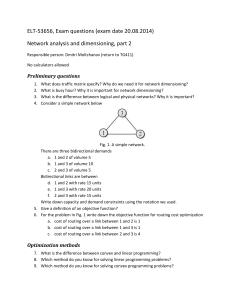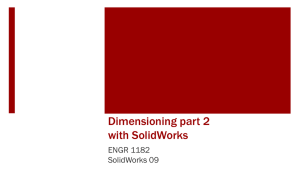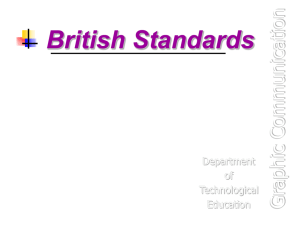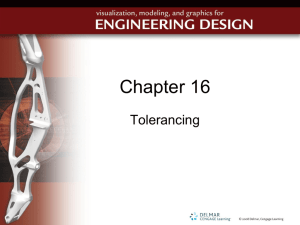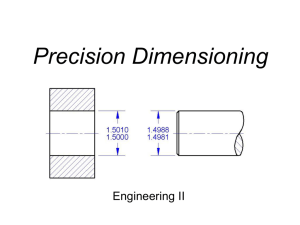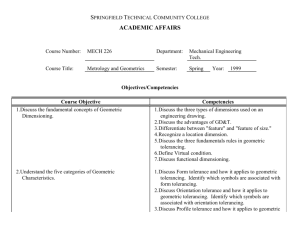Dimensioning Methods.Limits.Tolerances - Ivy Tech -
advertisement
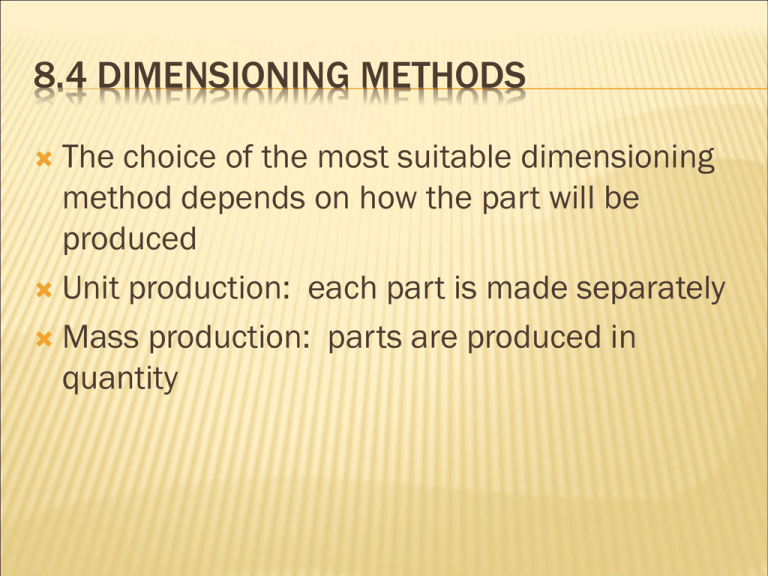
8.4 DIMENSIONING METHODS The choice of the most suitable dimensioning method depends on how the part will be produced Unit production: each part is made separately Mass production: parts are produced in quantity RECTANGULAR COORDINATE DIMENSIONING Linear dimensions are measured paralle or perpendicular to reference axes or datum planes that are perpendicular to one another (fig.8-36) Arbitrary points (fig.8-37,8-38) Without dimension lines (fig. 8-39) Tabular dimensioning (fig.8-40) POLAR COORDINATE DIMENSIONING Circular planes or circular configurations of features (fig.8-42a) Position is determined by a linear dimension and angle Chordal dimensioning (fig.8.42b) CHAIN DIMENSIONING A series of dimensions is applied on a point-topoint basis (fig. 8-44) Undesirable accumulation of tolerances between individual features can result DATUM OR COMMON-POINT DIMENSIONING Several dimensions emanate from a common reference point or line (fig.8-45) Parallel method Superimposed method-dimensions should be placed near the arrowhead in line with the corresponding extension line and the origin is indicated by a circle (fig.8-46) 8-5 LIMITS AND TOLERANCES Why? Exact dimensions and shapes can not be attained in the manufacture of materials and products Slight variations in size can be tolerated without impairing its function Interchangeable parts need not be identical Restrict the variations with limits and tolerances TOLERANCES Definition: Tolerances are the permissible variations in the specified form, size, or location of individual features of a part from that shown in the drawing. Definition: Limits are the largest and smallest permissible sizes TERMINOLOGY OF TOLERANCES AND LIMITS Actual size-the measured size Basic size-the theoretical size from which the limits are derived Nominal size-the designation used for the purpose of general identification Tolerance-tolerance of a dimension is the total permissible variation in size of a dimension…the mathematical difference between the limits of size TERMINOLOGY CONTINUED Bilateral tolerance-variation is permitted in both directions from the specified dimension [1.5±.004] Unilateral tolerance-variation is permitted in only one direction from the specified dimension [1.5+.004] Maximum material size-the limit of size of a feature that results in the part containing the maximum amount of material (GDT) TOLERANCING-ALL DIMENSIONS REQUIRED IN MANUFACTURE OF A PRODUCT HAVE A TOLERANCE Limits of tolerance directly on the drawing (fig.8-48) +/- tolerancing (equal and unequal) General tolerance note referring to all dimensions or specific dimensions LIMIT DIMENSIONING The high limit (maximum value) is placed above the low limit (minimum value) When expressed in a single line, the low limit precedes the high limit and they are seperated by a dash The digits to the right of the decimal place should match for both limits (English & SI) PLUS-AND-MINUS TOLERANCING (FIG.8-50) Specified size given first followed by a +/expression of tolerancing. Plus value placed above minus value METRIC TOLERANCING RULES The dimension need not be shown to the same number of decimal places as its tolerance 1.5±0.04 NOT 1.50 ±0.04 10 ±0.1 NOT 10.0 ±0.1 Metric bilateral tolerances-both +/-must have the same number of decimal places using zeros if necessary 30+0.15 -0.10 NOT 30+0.15 -0.1 When a unilateral tolerance is used and either value is nil, a single zero is used 40 0 -0.15 INCH TOLERANCING RULES The dimension is given to the same number of decimals as its tolerance .500 ±.004 NOT .50 ±.004 .750+.500 NOT .750+.500 -.000 -0 TOLERANCE ACCUMULATION A chain of tolerances can build up a cumulative tolerance between surfaces that have an important relation to one another (fig.8-52) Chain (greatest tolerance accumulation) Datum (lesser tolerance accumulation) Direct (least tolerance accumulation) ADDITIONAL RULES FOR DIMENSIONING Design intent Completely describe part geometry Avoid unnecessary accumulation of tolerances Manufacturing methods are not specified Dimension to visible lines (NOT hidden lines) In general, place dimensions outside the outline of the part and between views Dimensions should be aligned, if practicable, and should be grouped for uniform appearance

